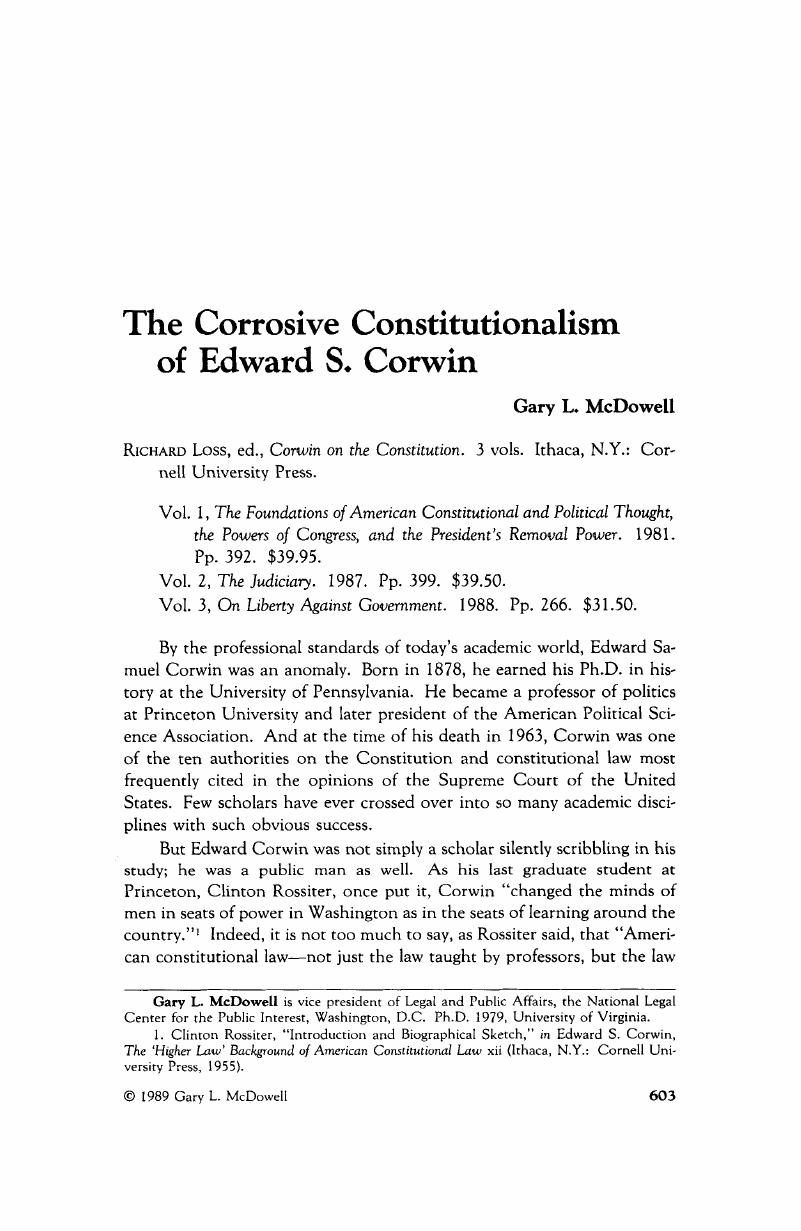No CrossRef data available.
Article contents
The Corrosive Constitutionalism of Edward S. Corwin
Published online by Cambridge University Press: 27 December 2018
Abstract

- Type
- Review Essay
- Information
- Copyright
- Copyright © American Bar Foundation, 1989
References
1 Rossiter, Clinton, “Introduction and Biographical Sketch,”in Edward S. Corwin, The ‘Higher Law’ Background of American Constitutional Law xii (Ithaca, N. Y.: Cornell University Press, 1955).Google Scholar
2 Id. at xi.Google Scholar
3 This is most obvious in the work of such contemporary writers as Ronald Dworkin, Michael Perry, Laurence Tribe, and Thomas Grey.Google Scholar
4 Ithaca, N. Y.: Cornell University Press, 1976 (“Loss, Presidential Power”).Google Scholar
5 See also vol. 2 at 183–93.Google Scholar
6 Clinton Rossiter would later put it even more forcefully: “[M]ost talk about the intent of the Framers–whether in the orations of politicians, the opinions of judges, or the monographs of professors, is as irrelevant as it is unpersuasive, as stale as it is strained, as rhetorically absurd as it is historically unsound.” This, somewhat paradoxically, appears in a book on the Constitutional Convention. 1787: The Grand Convention 333 (New York: Macmillan, 1966).Google Scholar
7 Corwin, Edward S., Court Over Constitution 68–69 (Princeton, N. J.: Princeton University Press, 1938).Google Scholar
8 To Corwin, “the Ninth Amendment illustrate[d] this theory perfectly… that the principles of transcendental justice have been translated into terms of personal and private rights… [which] owe nothing to their recognition in the Constitution” (vol. 1 at 81).Google Scholar
9 As Blackstone put it: “this law of nature, being coeval with mankind, and dictated by God himself, is, of course, superior in obligation to any other. It is binding all over the globe, in all countries, and at all times. No human laws are of any validity, if contrary to this. And such of them as are valid, derive all their force, and all their original authority mediately or immediately, from this original.” 1 Commentaries on the Laws of England (Chicago: University of Chicago Press, 1979).Google Scholar
10 In particular, Corwin noted, the Court, throughout its history, has never truly practiced what it preached. The Court as a general rule denies that any “legislative act may be pronounced void… on the ground of it being in conflict with natural justice, the social compact [or] fundamental principles” (vol. 2 at 198). But in fact, while natural rights were being “expelled from the front door of the Constitution,” they were being readmitted through the back door, “through the doctrine of separation of powers (vol. 3 at 31). For once it was established that the Court had the power “finally and authoritatively” to define the limits of powers under the Constitution, “the power of judicial review became limited only by the discretion of the judges and the operation of state decisis” (vol. 3 at 31). By exercising its discretion to enforce the doctrine of separation of powers, the Court, with its unavoidable reliance on “judicial right reason,” is no longer, strictly speaking, bound by the written Constitution (vol. 3 at 31).Google Scholar
11 Coke as quoted in Corwin, The ‘Higher Law’ Background (vol. 1 at 39).Google Scholar
12 Corwin, “The Dissolving Structure of Our Constitutional Law,”in Loss, Presidential Power 154–55 (cited in note 4).Google Scholar
13 Id. at 149.Google Scholar
14 Id. at 156.Google Scholar
15 Id. at 155.Google Scholar
16 Corwin, Edward S., Constitutional Revolution, Ltd. 111 (Claremont, California, 1941).Google Scholar
17 Dworkin, Ronald, Taking Rights Seriously 149 (Cambridge, Mass.: Harvard University Press, 1976) (“Dworkin, Taking Rights Seriously”).Google Scholar
18 Shapiro, Martin, “Judge as Statesman, Judge as Pol,”N. Y. Times, Nov. 21, 1981 (Book Review Section), at 42; White, G. Edward, Earl Warren: A Public Life 350–69 (New York: Oxford University Press, 1982); Bickel, Alexander M., The Supreme Court and the Idea of Progress 134 (New York: Harper & Row, 1970).Google Scholar
19 Fiss, Owen, “The Forms of Justice,” 93 Harv. L. Rev. 1, 9 (1979).Google Scholar
20 Faulkner, Robert K., “Bickel's Constitution: The Problem of Moderate Liberalism,” 72 Am. Pol. Sci. Rev. 925 (1978).Google Scholar
21 Bickel, Alexander M., The Morality of Consent 142 (New Haven, Conn.: Yale University Press, 1974).Google Scholar
22 Id. at 12.Google Scholar
23 Dworkin, Taking Rights Seriously 147.Google Scholar
24 Tribe, Laurence, American Constitutional Law iii, 892 (Mineola, N. Y.: Foundation Press, 1978).Google Scholar
25 Id. at 889, 891.Google Scholar
26 Perry, Michael, The Constitution, the Court, and Human Rights 123, 125, 101, 111, 99 (New Haven, Conn.: Yale University Press, 1980).Google Scholar
27 Id. at 101.Google Scholar
28 Bobbitt, Philip, Constitutional Fate 94, 125 (New York: Oxford University Press, 1982).Google Scholar
29 Id. at 143.Google Scholar
30 Grey, Thomas, “Do We Have an Unwritten Constitution?” 27 Stan. L. Rev. 703, 714 (1975).Google Scholar
31 Id. at 715–16.Google Scholar


